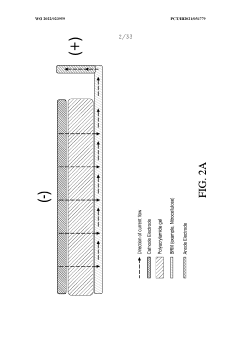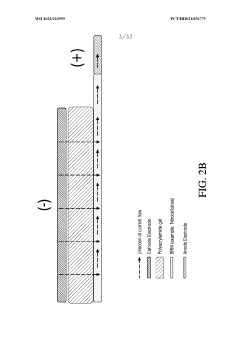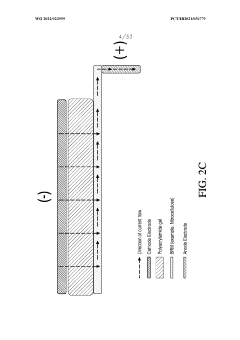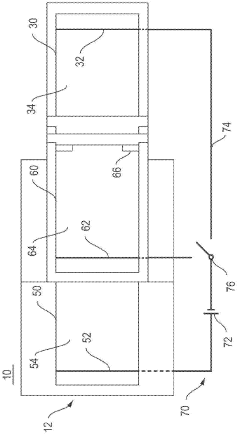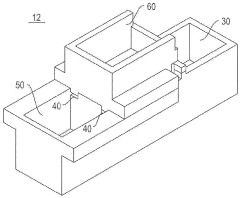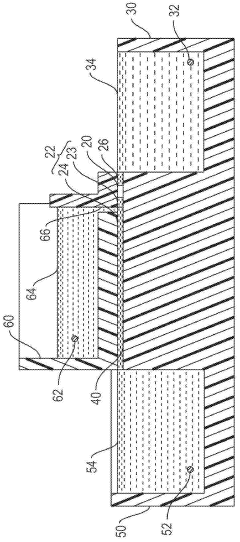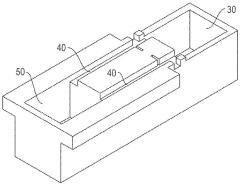How to Troubleshoot Common Gel Electrophoresis Issues?
JUN 30, 20259 MIN READ
Generate Your Research Report Instantly with AI Agent
Patsnap Eureka helps you evaluate technical feasibility & market potential.
Gel Electrophoresis Fundamentals and Objectives
Gel electrophoresis is a fundamental technique in molecular biology, widely used for separating and analyzing DNA, RNA, and proteins based on their size and electrical charge. The method has evolved significantly since its inception in the 1960s, becoming an indispensable tool in various fields, including genetics, forensics, and medical diagnostics. Understanding the principles and objectives of gel electrophoresis is crucial for troubleshooting common issues that may arise during the procedure.
The basic principle of gel electrophoresis relies on the migration of charged molecules through a porous gel matrix under the influence of an electric field. DNA and RNA molecules, being negatively charged due to their phosphate backbone, move towards the positive electrode. Proteins, depending on their amino acid composition and the pH of the buffer, can move towards either electrode. The gel matrix, typically made of agarose or polyacrylamide, acts as a molecular sieve, allowing smaller molecules to move faster than larger ones.
The primary objectives of gel electrophoresis in the context of troubleshooting include accurate size determination of nucleic acids or proteins, separation of mixed samples, and quality assessment of purified molecules. For DNA and RNA analysis, gel electrophoresis can reveal the integrity of samples, detect contamination, and estimate concentration. In protein analysis, it can separate complex mixtures and provide information on protein size, charge, and post-translational modifications.
Recent technological advancements have expanded the capabilities of gel electrophoresis. Pulsed-field gel electrophoresis (PFGE) allows for the separation of much larger DNA fragments, up to several megabases in size. Capillary electrophoresis offers higher resolution and automation, while two-dimensional gel electrophoresis provides enhanced separation of complex protein mixtures.
Understanding these fundamentals is essential when troubleshooting common issues in gel electrophoresis. Problems such as uneven band migration, smearing, or faint bands often have roots in the basic principles of the technique. For instance, irregular band patterns may result from uneven electric field distribution, while smearing could be due to sample overloading or degradation.
The objectives of troubleshooting in gel electrophoresis are to identify the source of the problem, implement corrective measures, and optimize the protocol for consistent, high-quality results. This process requires a systematic approach, considering factors such as sample preparation, gel composition, buffer conditions, and electrophoresis parameters. By mastering the fundamentals and understanding the objectives, researchers can effectively diagnose and resolve issues, ensuring reliable and reproducible results in their experiments.
The basic principle of gel electrophoresis relies on the migration of charged molecules through a porous gel matrix under the influence of an electric field. DNA and RNA molecules, being negatively charged due to their phosphate backbone, move towards the positive electrode. Proteins, depending on their amino acid composition and the pH of the buffer, can move towards either electrode. The gel matrix, typically made of agarose or polyacrylamide, acts as a molecular sieve, allowing smaller molecules to move faster than larger ones.
The primary objectives of gel electrophoresis in the context of troubleshooting include accurate size determination of nucleic acids or proteins, separation of mixed samples, and quality assessment of purified molecules. For DNA and RNA analysis, gel electrophoresis can reveal the integrity of samples, detect contamination, and estimate concentration. In protein analysis, it can separate complex mixtures and provide information on protein size, charge, and post-translational modifications.
Recent technological advancements have expanded the capabilities of gel electrophoresis. Pulsed-field gel electrophoresis (PFGE) allows for the separation of much larger DNA fragments, up to several megabases in size. Capillary electrophoresis offers higher resolution and automation, while two-dimensional gel electrophoresis provides enhanced separation of complex protein mixtures.
Understanding these fundamentals is essential when troubleshooting common issues in gel electrophoresis. Problems such as uneven band migration, smearing, or faint bands often have roots in the basic principles of the technique. For instance, irregular band patterns may result from uneven electric field distribution, while smearing could be due to sample overloading or degradation.
The objectives of troubleshooting in gel electrophoresis are to identify the source of the problem, implement corrective measures, and optimize the protocol for consistent, high-quality results. This process requires a systematic approach, considering factors such as sample preparation, gel composition, buffer conditions, and electrophoresis parameters. By mastering the fundamentals and understanding the objectives, researchers can effectively diagnose and resolve issues, ensuring reliable and reproducible results in their experiments.
Market Demand for Improved Electrophoresis Techniques
The market demand for improved electrophoresis techniques has been steadily growing, driven by the increasing complexity of research in molecular biology, genetics, and biochemistry. As gel electrophoresis remains a fundamental tool in these fields, researchers and laboratories are constantly seeking more efficient, accurate, and user-friendly methods to troubleshoot common issues and enhance overall performance.
One of the primary drivers of market demand is the need for higher resolution and sensitivity in separating DNA, RNA, and protein samples. Traditional gel electrophoresis techniques often struggle with resolving closely sized fragments or detecting low-abundance molecules. This has led to a growing interest in advanced electrophoresis systems that can provide better separation and visualization of complex samples.
Automation and standardization have also become key factors in the market demand for improved electrophoresis techniques. Many laboratories are looking for solutions that can reduce human error, increase reproducibility, and streamline workflows. This includes automated gel loading systems, integrated imaging and analysis software, and standardized protocols that can be easily implemented across different research settings.
The increasing focus on personalized medicine and genomics has further fueled the demand for more sophisticated electrophoresis techniques. As researchers delve deeper into genetic variations and biomarkers, there is a growing need for electrophoresis methods that can handle large-scale genomic studies and provide high-throughput analysis capabilities.
Environmental concerns and sustainability initiatives have also influenced market demand. Laboratories are increasingly seeking eco-friendly alternatives to traditional electrophoresis methods, which often involve the use of toxic chemicals and generate significant waste. This has led to a rise in demand for greener electrophoresis technologies that reduce environmental impact without compromising performance.
In the clinical diagnostics sector, there is a growing demand for point-of-care electrophoresis systems that can provide rapid and accurate results. This is particularly important in areas such as infectious disease diagnosis, where quick turnaround times can significantly impact patient care and treatment decisions.
The academic research sector continues to be a major driver of market demand for improved electrophoresis techniques. Universities and research institutions are constantly pushing the boundaries of scientific discovery, requiring more advanced and versatile electrophoresis tools to support their cutting-edge research projects.
Lastly, the biopharmaceutical industry's expansion has created a substantial demand for high-performance electrophoresis techniques in drug development and quality control processes. As the complexity of biologic drugs increases, so does the need for more sophisticated analytical tools to ensure product purity and consistency.
One of the primary drivers of market demand is the need for higher resolution and sensitivity in separating DNA, RNA, and protein samples. Traditional gel electrophoresis techniques often struggle with resolving closely sized fragments or detecting low-abundance molecules. This has led to a growing interest in advanced electrophoresis systems that can provide better separation and visualization of complex samples.
Automation and standardization have also become key factors in the market demand for improved electrophoresis techniques. Many laboratories are looking for solutions that can reduce human error, increase reproducibility, and streamline workflows. This includes automated gel loading systems, integrated imaging and analysis software, and standardized protocols that can be easily implemented across different research settings.
The increasing focus on personalized medicine and genomics has further fueled the demand for more sophisticated electrophoresis techniques. As researchers delve deeper into genetic variations and biomarkers, there is a growing need for electrophoresis methods that can handle large-scale genomic studies and provide high-throughput analysis capabilities.
Environmental concerns and sustainability initiatives have also influenced market demand. Laboratories are increasingly seeking eco-friendly alternatives to traditional electrophoresis methods, which often involve the use of toxic chemicals and generate significant waste. This has led to a rise in demand for greener electrophoresis technologies that reduce environmental impact without compromising performance.
In the clinical diagnostics sector, there is a growing demand for point-of-care electrophoresis systems that can provide rapid and accurate results. This is particularly important in areas such as infectious disease diagnosis, where quick turnaround times can significantly impact patient care and treatment decisions.
The academic research sector continues to be a major driver of market demand for improved electrophoresis techniques. Universities and research institutions are constantly pushing the boundaries of scientific discovery, requiring more advanced and versatile electrophoresis tools to support their cutting-edge research projects.
Lastly, the biopharmaceutical industry's expansion has created a substantial demand for high-performance electrophoresis techniques in drug development and quality control processes. As the complexity of biologic drugs increases, so does the need for more sophisticated analytical tools to ensure product purity and consistency.
Current Challenges in Gel Electrophoresis
Gel electrophoresis remains a cornerstone technique in molecular biology, yet it continues to present several challenges that can impact the quality and reliability of results. One of the most persistent issues is inconsistent band resolution, which can arise from various factors such as improper gel concentration, suboptimal running conditions, or sample overloading. Researchers often struggle to achieve clear separation of DNA or protein fragments, particularly when dealing with complex mixtures or closely sized molecules.
Another significant challenge is the occurrence of smeared or distorted bands. This can be caused by DNA degradation, protein denaturation, or contamination of samples. Such issues not only compromise the accuracy of size estimation but also hinder the interpretation of experimental results. Additionally, the presence of background noise or non-specific staining can obscure faint bands and lead to misinterpretation of data.
The formation of air bubbles during gel casting or running is a common technical hurdle that can disrupt the uniform migration of molecules through the gel matrix. These bubbles can cause irregular band patterns and affect the overall quality of the electrophoretic separation. Furthermore, issues with buffer composition and pH can lead to inconsistent migration rates and affect the reproducibility of results across different experiments.
Gel electrophoresis also faces challenges related to sensitivity and detection limits. Traditional staining methods may not be sufficient for visualizing low-abundance molecules or small fragments, necessitating the use of more advanced and often costlier detection techniques. This limitation can be particularly problematic in applications such as trace DNA analysis or the detection of rare protein isoforms.
The time-consuming nature of gel electrophoresis poses another challenge, especially in high-throughput environments. The process of gel preparation, sample loading, running, and imaging can be labor-intensive and limit the number of samples that can be analyzed in a given timeframe. This bottleneck can slow down research progress and delay critical decision-making in both academic and industrial settings.
Environmental concerns also present challenges in gel electrophoresis. The use of toxic staining agents like ethidium bromide raises safety and disposal issues. While alternatives exist, they often come with trade-offs in terms of sensitivity or cost. Additionally, the high consumption of plastic consumables in gel electrophoresis contributes to laboratory waste, prompting a need for more sustainable practices.
Lastly, the interpretation of gel electrophoresis results can be subjective, particularly when dealing with complex band patterns or faint signals. This subjectivity can lead to inconsistencies in data analysis and reporting across different researchers or laboratories. The development of standardized protocols and automated analysis tools remains an ongoing challenge in the field.
Another significant challenge is the occurrence of smeared or distorted bands. This can be caused by DNA degradation, protein denaturation, or contamination of samples. Such issues not only compromise the accuracy of size estimation but also hinder the interpretation of experimental results. Additionally, the presence of background noise or non-specific staining can obscure faint bands and lead to misinterpretation of data.
The formation of air bubbles during gel casting or running is a common technical hurdle that can disrupt the uniform migration of molecules through the gel matrix. These bubbles can cause irregular band patterns and affect the overall quality of the electrophoretic separation. Furthermore, issues with buffer composition and pH can lead to inconsistent migration rates and affect the reproducibility of results across different experiments.
Gel electrophoresis also faces challenges related to sensitivity and detection limits. Traditional staining methods may not be sufficient for visualizing low-abundance molecules or small fragments, necessitating the use of more advanced and often costlier detection techniques. This limitation can be particularly problematic in applications such as trace DNA analysis or the detection of rare protein isoforms.
The time-consuming nature of gel electrophoresis poses another challenge, especially in high-throughput environments. The process of gel preparation, sample loading, running, and imaging can be labor-intensive and limit the number of samples that can be analyzed in a given timeframe. This bottleneck can slow down research progress and delay critical decision-making in both academic and industrial settings.
Environmental concerns also present challenges in gel electrophoresis. The use of toxic staining agents like ethidium bromide raises safety and disposal issues. While alternatives exist, they often come with trade-offs in terms of sensitivity or cost. Additionally, the high consumption of plastic consumables in gel electrophoresis contributes to laboratory waste, prompting a need for more sustainable practices.
Lastly, the interpretation of gel electrophoresis results can be subjective, particularly when dealing with complex band patterns or faint signals. This subjectivity can lead to inconsistencies in data analysis and reporting across different researchers or laboratories. The development of standardized protocols and automated analysis tools remains an ongoing challenge in the field.
Common Troubleshooting Approaches
01 Gel composition and preparation
Various gel compositions and preparation methods are used in gel electrophoresis. These include specific formulations of polyacrylamide gels, agarose gels, and other polymer-based gels. The composition and preparation of these gels are crucial for achieving optimal separation of molecules based on size and charge.- Gel composition and preparation: Various gel compositions and preparation methods are used in gel electrophoresis. These include specific formulations of polymers, cross-linking agents, and buffer solutions to create gels with desired properties for different applications. The composition and preparation of the gel matrix significantly influence the separation and resolution of biomolecules during electrophoresis.
- Electrophoresis apparatus design: Innovations in electrophoresis apparatus design focus on improving efficiency, reproducibility, and ease of use. These designs may include novel electrode configurations, buffer circulation systems, temperature control mechanisms, and integrated detection systems. Advanced apparatus designs aim to enhance separation quality and increase throughput for various analytical applications.
- Sample loading and separation techniques: Advancements in sample loading and separation techniques for gel electrophoresis include methods for improved sample introduction, novel buffer systems, and optimized running conditions. These techniques aim to enhance resolution, reduce band broadening, and increase the overall efficiency of biomolecule separation in various applications such as DNA, RNA, and protein analysis.
- Detection and imaging methods: Various detection and imaging methods are employed in gel electrophoresis to visualize and analyze separated biomolecules. These include fluorescence-based detection, chemiluminescence, colorimetric methods, and advanced imaging technologies. Improvements in detection sensitivity and quantification accuracy enable researchers to obtain more detailed information from electrophoresis experiments.
- Microfluidic and miniaturized systems: Miniaturized and microfluidic gel electrophoresis systems offer advantages such as reduced sample and reagent consumption, faster analysis times, and potential for integration with other analytical techniques. These systems often incorporate novel fabrication methods, materials, and designs to achieve high-performance separations in a compact format suitable for point-of-care or field applications.
02 Electrophoresis apparatus design
Innovations in electrophoresis apparatus design focus on improving efficiency, resolution, and ease of use. These designs may include novel electrode configurations, buffer systems, and sample loading mechanisms. Some apparatuses are designed for specific applications or to handle multiple samples simultaneously.Expand Specific Solutions03 Detection and analysis methods
Various detection and analysis methods are employed in gel electrophoresis to visualize and quantify separated molecules. These may include fluorescence-based detection, staining techniques, and advanced imaging systems. Some methods focus on real-time monitoring of the electrophoresis process or automated analysis of results.Expand Specific Solutions04 Specialized electrophoresis techniques
Specialized electrophoresis techniques have been developed for specific applications or to improve separation of certain types of molecules. These may include pulsed-field gel electrophoresis, capillary electrophoresis, or two-dimensional gel electrophoresis. Each technique offers unique advantages for particular research or diagnostic purposes.Expand Specific Solutions05 Sample preparation and loading
Innovations in sample preparation and loading for gel electrophoresis aim to improve accuracy, reproducibility, and efficiency. These may include novel buffer formulations, sample concentration techniques, or automated loading systems. Some methods focus on preserving sample integrity or enhancing the separation of specific types of molecules.Expand Specific Solutions
Key Players in Electrophoresis Industry
The gel electrophoresis troubleshooting market is in a mature stage, with established techniques and a wide range of commercial solutions available. The global market size for electrophoresis equipment and supplies is estimated to be over $1 billion, driven by ongoing demand in research, diagnostics, and forensics. Leading players like Bio-Rad Laboratories, Life Technologies, and Thermo Fisher Scientific offer comprehensive product lines and technical support. These companies have developed advanced automated systems and high-performance reagents to address common issues like poor band resolution, uneven migration, and background staining. While the core technology is well-established, there is continued innovation in areas like microfluidic devices, multiplexed systems, and software for image analysis and data interpretation.
Life Technologies Corp.
Technical Solution: Life Technologies Corp. has developed advanced troubleshooting techniques for gel electrophoresis issues. Their approach includes a comprehensive system for identifying and resolving common problems such as poor band resolution, smearing, and uneven migration. They utilize specialized buffer systems and optimized gel formulations to enhance separation quality[1]. The company has also introduced automated gel documentation systems with integrated analysis software for rapid identification of electrophoresis anomalies[3]. Additionally, they offer a range of pre-cast gels and buffer solutions specifically designed to address common issues like background staining and gel inconsistencies[5].
Strengths: Comprehensive troubleshooting system, advanced automation, and specialized products. Weaknesses: Potential over-reliance on proprietary solutions, which may limit flexibility for some researchers.
Bio-Rad Laboratories, Inc.
Technical Solution: Bio-Rad Laboratories has developed a multi-faceted approach to troubleshooting gel electrophoresis issues. Their strategy includes the use of high-precision power supplies to ensure consistent voltage and current during runs, minimizing band distortion[2]. They have also created a line of specialized reagents and buffers that help prevent common problems like smiling and swirling patterns in gels[4]. Bio-Rad's troubleshooting protocol incorporates real-time monitoring systems that can detect and alert users to potential issues during the electrophoresis process, allowing for immediate corrective action[6]. Furthermore, they offer extensive educational resources and technical support to help researchers identify and resolve electrophoresis problems efficiently.
Strengths: Comprehensive product ecosystem, real-time monitoring capabilities, and strong educational support. Weaknesses: Some solutions may be tied to specific Bio-Rad equipment, potentially limiting compatibility with other systems.
Innovative Solutions for Electrophoresis Issues
Electrotransfer & electrophoresis devices, systems, & methods
PatentWO2022023959A1
Innovation
- A single system for gel electrophoresis, electrotransfer, and detection that includes a device with a biomolecule receiving material and electrodes arranged to allow current flow in multiple directions, enabling efficient transfer and detection of biomolecules with reduced buffer volumes and hazardous waste, and improved antibody recognition.
Gel electrophoresis apparatus and gel electrophoresis method
PatentWO2015133190A1
Innovation
- A gel electrophoresis apparatus and method that includes a well for whole blood, with a power supply system to switch voltage application between electrodes, allowing electrophoresis to resume by switching from the first and second electrodes to the second and third electrodes, preventing blood cells from accumulating in the electrophoretic gel and maintaining the energizing function of the second and third electrodes.
Quality Control in Gel Electrophoresis
Quality control is a critical aspect of gel electrophoresis that ensures reliable and reproducible results. Implementing a robust quality control system involves several key components, each contributing to the overall accuracy and precision of the technique.
One of the primary elements of quality control in gel electrophoresis is the use of standardized protocols. These protocols should cover all aspects of the process, from sample preparation to gel casting, running conditions, and imaging. By adhering to well-established procedures, laboratories can minimize variability between experiments and operators.
Regular maintenance and calibration of equipment are essential for maintaining consistent performance. This includes routine checks of power supplies, gel boxes, and imaging systems. Proper documentation of maintenance activities and equipment logs helps track performance over time and identify potential issues before they impact results.
The quality of reagents and materials used in gel electrophoresis significantly affects the outcome. Implementing a system for tracking lot numbers, expiration dates, and storage conditions of all reagents ensures that only high-quality materials are used. Regular quality checks of commonly used buffers and solutions, such as TBE or TAE, help maintain consistent running conditions.
Incorporating positive and negative controls in each experiment is crucial for validating results. These controls serve as benchmarks for expected outcomes and help identify potential problems in the experimental setup. Additionally, the use of DNA ladders or molecular weight markers in every gel provides a reference for size determination and allows for inter-gel comparisons.
Proper sample preparation and handling are vital for obtaining accurate results. This includes using appropriate methods for DNA extraction and purification, as well as maintaining sample integrity through proper storage and handling practices. Implementing guidelines for sample concentration and loading volume helps ensure consistent band intensity and resolution across gels.
Image acquisition and analysis are critical steps in the gel electrophoresis process. Establishing standardized imaging protocols, including exposure times and image processing parameters, helps ensure consistent and comparable results. The use of image analysis software with appropriate calibration can improve the accuracy of quantitative measurements.
Regular proficiency testing and inter-laboratory comparisons can help identify systematic errors and improve overall quality. Participating in external quality assessment programs provides an opportunity to benchmark performance against other laboratories and identify areas for improvement.
Implementing a comprehensive documentation system is essential for maintaining quality control. This includes detailed record-keeping of experimental conditions, observations, and results. Such documentation facilitates troubleshooting, ensures reproducibility, and supports regulatory compliance in research and clinical settings.
One of the primary elements of quality control in gel electrophoresis is the use of standardized protocols. These protocols should cover all aspects of the process, from sample preparation to gel casting, running conditions, and imaging. By adhering to well-established procedures, laboratories can minimize variability between experiments and operators.
Regular maintenance and calibration of equipment are essential for maintaining consistent performance. This includes routine checks of power supplies, gel boxes, and imaging systems. Proper documentation of maintenance activities and equipment logs helps track performance over time and identify potential issues before they impact results.
The quality of reagents and materials used in gel electrophoresis significantly affects the outcome. Implementing a system for tracking lot numbers, expiration dates, and storage conditions of all reagents ensures that only high-quality materials are used. Regular quality checks of commonly used buffers and solutions, such as TBE or TAE, help maintain consistent running conditions.
Incorporating positive and negative controls in each experiment is crucial for validating results. These controls serve as benchmarks for expected outcomes and help identify potential problems in the experimental setup. Additionally, the use of DNA ladders or molecular weight markers in every gel provides a reference for size determination and allows for inter-gel comparisons.
Proper sample preparation and handling are vital for obtaining accurate results. This includes using appropriate methods for DNA extraction and purification, as well as maintaining sample integrity through proper storage and handling practices. Implementing guidelines for sample concentration and loading volume helps ensure consistent band intensity and resolution across gels.
Image acquisition and analysis are critical steps in the gel electrophoresis process. Establishing standardized imaging protocols, including exposure times and image processing parameters, helps ensure consistent and comparable results. The use of image analysis software with appropriate calibration can improve the accuracy of quantitative measurements.
Regular proficiency testing and inter-laboratory comparisons can help identify systematic errors and improve overall quality. Participating in external quality assessment programs provides an opportunity to benchmark performance against other laboratories and identify areas for improvement.
Implementing a comprehensive documentation system is essential for maintaining quality control. This includes detailed record-keeping of experimental conditions, observations, and results. Such documentation facilitates troubleshooting, ensures reproducibility, and supports regulatory compliance in research and clinical settings.
Environmental Impact of Electrophoresis Reagents
Gel electrophoresis, while a powerful analytical technique, utilizes various reagents that can have significant environmental impacts. The primary concern lies in the disposal of these chemicals, which often contain hazardous substances. Ethidium bromide, a common DNA stain, is a potent mutagen and potential carcinogen. When improperly disposed of, it can contaminate soil and water sources, posing risks to ecosystems and human health. Similarly, acrylamide, used in polyacrylamide gels, is neurotoxic and can persist in the environment.
The buffers used in electrophoresis, such as Tris-borate-EDTA (TBE) and Tris-acetate-EDTA (TAE), contain chemicals that can alter the pH of aquatic environments when released. This pH change can disrupt local ecosystems, affecting the survival of aquatic organisms. Additionally, the heavy metals present in some electrophoresis reagents, like silver from silver staining techniques, can accumulate in the food chain and cause long-term ecological damage.
Agarose, while biodegradable, is often mixed with non-biodegradable substances during gel preparation, complicating its environmental impact. The production of agarose also raises sustainability concerns, as it is derived from seaweed, and increased demand could lead to overexploitation of marine resources.
To mitigate these environmental impacts, many laboratories are adopting more eco-friendly practices. This includes using alternative, less toxic DNA stains like SYBR Safe or GelRed, which are designed to be less mutagenic and more environmentally benign. Some facilities are implementing waste segregation and treatment protocols to ensure proper disposal of electrophoresis waste. Advanced oxidation processes and activated carbon filtration are being employed to treat contaminated wastewater before release.
Research is ongoing to develop more sustainable electrophoresis techniques. This includes exploring biodegradable gel materials, recyclable buffer systems, and non-toxic staining methods. Some labs are investigating the use of microfluidic devices for electrophoresis, which significantly reduce reagent consumption and waste generation. Additionally, there is a growing trend towards digital imaging systems that eliminate the need for certain staining procedures altogether, further reducing the environmental footprint of gel electrophoresis.
As awareness of the environmental impact of laboratory practices grows, there is an increasing emphasis on green chemistry principles in electrophoresis. This holistic approach considers the entire lifecycle of reagents, from production to disposal, aiming to minimize environmental harm while maintaining analytical efficiency. By addressing these environmental concerns, the scientific community is working towards making gel electrophoresis a more sustainable and environmentally responsible technique.
The buffers used in electrophoresis, such as Tris-borate-EDTA (TBE) and Tris-acetate-EDTA (TAE), contain chemicals that can alter the pH of aquatic environments when released. This pH change can disrupt local ecosystems, affecting the survival of aquatic organisms. Additionally, the heavy metals present in some electrophoresis reagents, like silver from silver staining techniques, can accumulate in the food chain and cause long-term ecological damage.
Agarose, while biodegradable, is often mixed with non-biodegradable substances during gel preparation, complicating its environmental impact. The production of agarose also raises sustainability concerns, as it is derived from seaweed, and increased demand could lead to overexploitation of marine resources.
To mitigate these environmental impacts, many laboratories are adopting more eco-friendly practices. This includes using alternative, less toxic DNA stains like SYBR Safe or GelRed, which are designed to be less mutagenic and more environmentally benign. Some facilities are implementing waste segregation and treatment protocols to ensure proper disposal of electrophoresis waste. Advanced oxidation processes and activated carbon filtration are being employed to treat contaminated wastewater before release.
Research is ongoing to develop more sustainable electrophoresis techniques. This includes exploring biodegradable gel materials, recyclable buffer systems, and non-toxic staining methods. Some labs are investigating the use of microfluidic devices for electrophoresis, which significantly reduce reagent consumption and waste generation. Additionally, there is a growing trend towards digital imaging systems that eliminate the need for certain staining procedures altogether, further reducing the environmental footprint of gel electrophoresis.
As awareness of the environmental impact of laboratory practices grows, there is an increasing emphasis on green chemistry principles in electrophoresis. This holistic approach considers the entire lifecycle of reagents, from production to disposal, aiming to minimize environmental harm while maintaining analytical efficiency. By addressing these environmental concerns, the scientific community is working towards making gel electrophoresis a more sustainable and environmentally responsible technique.
Unlock deeper insights with Patsnap Eureka Quick Research — get a full tech report to explore trends and direct your research. Try now!
Generate Your Research Report Instantly with AI Agent
Supercharge your innovation with Patsnap Eureka AI Agent Platform!

